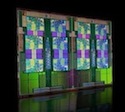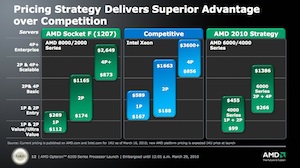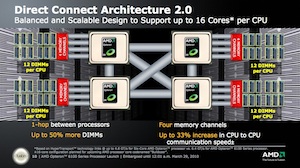 After a long and reasonably well-orchestrated marketing run up, plus a few partner slips, AMD has finally brought its 8- and 12-core “Magny-Cours” processor to market. The pitch: they have more cores, and by adopting a single platform underneath both the four socket and two socket variants of the platform, they’ve eliminated the 4-socket penalty. I talked to AMD’s John Fruehe last week to get the skinny on AMD’s new fat sockets.
After a long and reasonably well-orchestrated marketing run up, plus a few partner slips, AMD has finally brought its 8- and 12-core “Magny-Cours” processor to market. The pitch: they have more cores, and by adopting a single platform underneath both the four socket and two socket variants of the platform, they’ve eliminated the 4-socket penalty. I talked to AMD’s John Fruehe last week to get the skinny on AMD’s new fat sockets.
Something for HPC system builders
 Let’s hit these in reverse order as it could have some specific relevance to HPC cluster builders. Today’s launch of the 6100 series is the first of a pair of launches that will include the 4000s series. The 6000 is so-numbered, according to AMD, because it logically between the 8000 and 2000 series chips that they were peddling in the last generation of silicon. Pricing for those devices was similar to Intel pricing at the time (and likely Xeon pricing going forward). The chart at right is one that AMD briefed me on last week, showing where AMD is headed with its new pricing strategy. The new platform is priced under the low end of the previous generation of products, and is about half of the previous generation at the very high end. So not only has AMD priced aggressively to try to regain market share from Intel, they’ve eliminated the money decision that customers used to have to make in pondering whether to build their clusters from 4- or 2-socket motherboards.
Let’s hit these in reverse order as it could have some specific relevance to HPC cluster builders. Today’s launch of the 6100 series is the first of a pair of launches that will include the 4000s series. The 6000 is so-numbered, according to AMD, because it logically between the 8000 and 2000 series chips that they were peddling in the last generation of silicon. Pricing for those devices was similar to Intel pricing at the time (and likely Xeon pricing going forward). The chart at right is one that AMD briefed me on last week, showing where AMD is headed with its new pricing strategy. The new platform is priced under the low end of the previous generation of products, and is about half of the previous generation at the very high end. So not only has AMD priced aggressively to try to regain market share from Intel, they’ve eliminated the money decision that customers used to have to make in pondering whether to build their clusters from 4- or 2-socket motherboards.
This will noticeably affect system prices in clusters that were using the 4P configuration previously (not many HPC customers used this configuration because of the price/performance problems). It also has the potential benefit of allowing customers (in the right situations) to build denser clusters with less switching equipment and floor space. The 6100 also sports 4 memory channels per CPU with 12 DDR3 memory slots, compared to the Xeon’s 3 and 9 respectively (see the architecture figure below), meaning that for a fixed memory capacity system builders can potentially use cheaper, lower capacity DIMMs in an AMD system.
What’s in the 6100 series
 Today’s launch of the 6100 series will be matched later this quarter with the launch of “Libson,” the 1P-2P Opteron 4000 series counterpart to today’s big brother. The 6100 comes in either eight or twelve cores and in either 2P or 4P configurations, though its the same chip and the same cores in each case. The 6100 itself is really two of the 4100 series chips in a single package, so AMD is really getting to amortize its engineering costs here. The 6100 uses the new Socket G34 (the 4100 will use Socket F). As mentioned earlier the 6100 supports 4 memory channels and 12 DDR3 DIMM slots per socket, making a total of 8 or 16 channels available (2P or 4P). In the 2P configuration this gives builders the option of packing in 128 GB of RAM, and AMD’s Fruehe says that all 12 DIMMs on a socket can use 1333MHz memory, something AMD claims that Intel cannot do. The platform uses HyperTransport 3, and in the four socket configuration supports a full crossbar between all of the sockets (see the figure) — the previous generation socket interconnect, called Direct Connect 1.0, required two hops between the most distant processor pairs.
Today’s launch of the 6100 series will be matched later this quarter with the launch of “Libson,” the 1P-2P Opteron 4000 series counterpart to today’s big brother. The 6100 comes in either eight or twelve cores and in either 2P or 4P configurations, though its the same chip and the same cores in each case. The 6100 itself is really two of the 4100 series chips in a single package, so AMD is really getting to amortize its engineering costs here. The 6100 uses the new Socket G34 (the 4100 will use Socket F). As mentioned earlier the 6100 supports 4 memory channels and 12 DDR3 DIMM slots per socket, making a total of 8 or 16 channels available (2P or 4P). In the 2P configuration this gives builders the option of packing in 128 GB of RAM, and AMD’s Fruehe says that all 12 DIMMs on a socket can use 1333MHz memory, something AMD claims that Intel cannot do. The platform uses HyperTransport 3, and in the four socket configuration supports a full crossbar between all of the sockets (see the figure) — the previous generation socket interconnect, called Direct Connect 1.0, required two hops between the most distant processor pairs.
The 6100s also feature some new engineering aimed at driving down power, including a new power state, the ability to reduce p-states when a temperature threshold is reached (“Cool Speed”), improved monitoring, and support for the lower voltage DDR3 DIMMs (when they become available). The 12-core variants come in speeds between 1.7 and 2.3GHz with ACPs of 65 (for the HE bin) and 105W (for the SE), with most of the line coming in at 80W in the “mid bin” parts. The 8-core chips range between 1.8 and 2.4GHz and consume 65 to 80W. There are 64KB of data and instruction cache per core, 512KB of L2 per core, and 12MB of L3 per socket. The four x16 HyperTransport 3 links provide up to a maximum of 6.4 GT/s per link.
Partners who need partners are the luckiest partners
AMD is buddying up with its usual launch partners today, and its blogs and marketing materials feature the likes of Cray, HP, Dell, and Microsoft. New to this lineup (for me anyway) is Acer. During our conversation Fruehe mentioned that Acer is building an HPC business of all things in Europe and Asia, and is beefing up for a push into the North American HPC space next year.




[…] case you missed it, be sure to check out our feature coverage of the launch.AKPC_IDS += "10684,"; Posted in Business of HPC, Compute, HPC Hardware by John […]